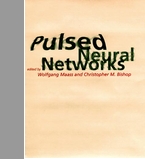Christopher M. Bishop Preface
Microsoft Research, Cambridge
Cambridge CB2 3NH, England, UK
cmbishop@microsoft.com
http://research.microsoft.com/~cmbishop/
Peter S. Burge Chapter 13
Department of Computer Science
Royal Holloway, University of London
Egham, England, UK
peter@neurocolt.com
Max R. van Daalen Chapter 13
Department of Computer Science
Royal Holloway, University of London
Egham, England, UK
max@dcs.rhbnc.ac.uk
Stephen R. Deiss Chapter 6
Applied Neurodynamics
Encinitas, CA, 92024-5354, USA
deiss@sba.cerf.net
Rodney J. Douglas Chapter 6
Institut für Neuroinformatik
Universität Zürich & ETH Zürich
Zürich, Switzerland
rjd@ini.phys.ethz.ch
John G. Elias Chapter 5
Department of Electrical and
Computer Engineering
University of Delaware
Newark, Delaware 19716, USA
elias@udel.edu
Wulfram Gerstner Chapters 1, 10, 14
Center for Neuromimetic Systems
Swiss Federal Institute of Technology, EPFL
CH-1015 Lausanne, Switzerland
Wulfram.Gerstner@di.epfl.ch
Alister Hamilton Chapter 8
Dept. of Electrical Engineering
University of Edinburgh
Edinburgh, Scotland, UK
Alister.Hamilton@ee.ed.ac.uk
J. Leo van Hemmen Chapter 14
Physik Department, TU München
D-85747 Garching bei München
München, Germany
Leo.van.Hemmen@Physik.TU-München.de
David Horn Chapter 11
School of Physics and Astronomy
Tel Aviv University
Tel Aviv, Israel
horn@neuron.tau.ac.il
Axel Jahnke Chapter 9
Institut of Microelectronics
TU Berlin
Berlin, Germany
jahnke@mikro.ee.tu-berlin.de
Richard Kempter Chapter 14
Institut für Theoretische Physik
Physik-Department der TU München
München, Germany
Richard.Kempter@Physik.TU-Muenchen.DE
Wolfgang Maass Preface, Chapters 2, 12
Institute of Theoretical Computer Science
Technische Universität Graz
A-8010 Graz, Austria
maass@igi.tu-graz.ac.at
Alessandro Mortara Chapter 7
Advanced Microelectronics Division
Centre Suisse d'Electronique
et de Microtechnique
Neuchatel, Switzerland
mortara@csemne.ch
|
|
Alan F. Murray Chapter 3
Dept. of Electrical Engineering
University of Edinburgh
Edinburgh, EH9 3JL., England, UK
Alan.Murray@ee.ed.ac.uk
David P. M. Northmore Chapter 5
Department of Psychology
University of Delaware
Newark, Delaware 19716, USA
northmor@udel.edu
Irit Opher Chapter 11
School of Physics and Astronomy
Tel Aviv University
Tel Aviv, Israel
irit@neuron.tau.ac.il
Kostas A. Papathanasiou Chapter 8
Department of Electrical
Engineering
University of Edinburgh
Edinburgh, Scotland, UK
Kostas.Papathanasiou@ee.ed.ac.uk
Michael Recce Chapter 4
Department of Computer and
Information Science
New Jersey Institute of Technology
Newark, NJ 07102, USA
recce@homer.njit.edu
Barry J. P. Rising Chapter 13
Department of Computer Science
Royal Holloway, University of
London
Egham, England, UK
barry@dcs.rhbnc.ac.uk
Ulrich Roth Chapter 9
Institut of Microelectronics
TU Berlin
Berlin, Germany
roth@mikro.ee.tu-berlin.de
Tim Schönauer Chapter 9
Institut of Microelectronics
TU Berlin
Berlin, Germany
tim@mikro.ee.tu-berlin.de
Terrence J. Sejnowski Foreword
The Salk Institute
La Jolla, CA 92037, USA
terry@salk.edu
John S. Shawe-Taylor Chapter 13
Department of Computer Science
Royal Holloway, University of
London
Egham, UK
john@dcs.rhbnc.ac.uk
Philippe Venier Chapter 7
Advanced Microelectronics Division
Centre Suisse d'Electronique
et de Microtechnique
Neuchatel, Switzerland
venier@csemne.ch
Hermann Wagner Chapter 14
Institut für Biologie
Lehrstuhl für Zoologie/Tier-
physiologie
RWTH Aachen
D-52074 Aachen, Germany
wagner@tyto.bio2.rwth-aachen.de
Adrian M. Whatley Chapter 6
Institut für Neuroinformatik
Universität Zürich & ETH Zürich
Zürich, Switzerland
amw@ini.phys.ethz.ch
Anthony M. Zador Chapter 12
The Salk Institute
La Jolla, CA 92037, USA
zador@salk.edu
|
